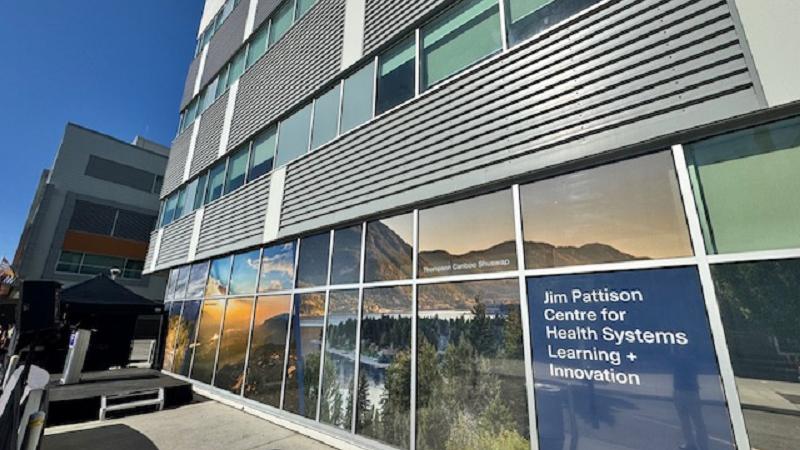The aroma of freshly-brewed coffee mingles with new paint as I step into what was once an administrative wing at Kelowna General Hospital. Today, this space has been transformed into something far more ambitious – the Jim Pattison Centre for Health Systems Learning and Innovation, which officially opened its doors last week after three years of planning and construction.
“We’re not just creating another medical building,” explains Dr. Renée Fernandez, the Centre’s inaugural director, as she guides me through sunlit corridors. “We’re creating a living laboratory where healthcare providers, patients, and innovators can collaborate to solve our most pressing healthcare challenges.”
The $18.5 million facility represents one of the most significant investments in healthcare innovation infrastructure in British Columbia’s Interior region. The Jim Pattison Foundation contributed $10 million to the project, with additional funding from provincial health allocations and community donations.
What strikes me immediately is how unlike a traditional hospital environment this space feels. Gone are the clinical white walls and fluorescent lighting. Instead, open collaborative workspaces blend seamlessly with simulation labs and community meeting rooms. A patient advisory council was consulted throughout the design process, resulting in spaces that feel welcoming rather than institutional.
“We spent nearly a year just listening to what our communities needed,” says Elder Margaret Pierre from the Okanagan Nation Alliance, who serves on the Centre’s community advisory board. “Too often, health innovation happens without Indigenous voices. Here, our knowledge and healing practices are part of the foundation.”
The Centre emerges at a critical moment for British Columbia’s healthcare system. According to a 2023 BC Medical Association report, nearly 1 million British Columbians lack a family doctor, with rural and Indigenous communities facing the most severe access challenges. Meanwhile, healthcare worker burnout rates have reached alarming levels, with Statistics Canada reporting that 70% of healthcare workers experienced high levels of burnout following the pandemic.
Inside one of the Centre’s simulation rooms, I watch as a team practices a complex emergency scenario. The mannequin patient speaks, bleeds, and displays vital signs that respond in real-time to interventions. The technology is impressive, but what’s more striking is how these tools are being deployed.
“Traditional medical training often happens in silos,” explains Dr. Mandeep Dhaliwal, the Centre’s education director. “Here, we’re training interdisciplinary teams – doctors alongside nurses, paramedics, community health workers, and patients themselves. Because that’s how real healthcare happens.”
In another wing, software developer Amina Rodriguez shows me a virtual reality program she’s developing to help patients manage chronic pain. Rodriguez isn’t a healthcare professional – she’s a tech entrepreneur working alongside clinicians to test and refine her innovation.
“Before this Centre opened, I had no way to collaborate directly with healthcare providers or test my ideas with actual patients,” Rodriguez tells me. “Now we can rapidly prototype, get feedback, and improve in days rather than years.”
The Centre’s approach addresses a long-standing frustration in Canadian healthcare innovation. According to the Canadian Medical Association Journal, Canada produces world-class medical research but often struggles to implement innovations within its healthcare system. The average time from discovery to widespread clinical adoption can exceed 17 years.
“We’re tackling what we call the implementation gap,” says Dr. Fernandez. “Having brilliant ideas isn’t enough if they never reach patients or if frontline staff can’t integrate them into their workflow.”
Perhaps the most distinctive feature of the Centre is its community collaboration spaces, where patient advocacy groups and community organizations can access resources previously available only to healthcare institutions. During my visit, I observe an Indigenous youth wellness group using motion capture technology to document traditional movement practices for integration into physical therapy programs.
Not everyone is convinced this approach will deliver on its promises. Dr. Martin Koehler, a healthcare policy analyst with the BC Centre for Health Policy, cautions that innovative facilities must translate to measurable improvements.
“The real question is whether this investment will improve access to primary care, reduce wait times, or address the healthcare worker crisis,” Koehler notes. “Innovation centers can become showcases rather than solutions if they’re not directly connected to systemic challenges.”
The Centre’s leadership acknowledges this concern. They’ve established metrics for success that include time-to-implementation for new practices, healthcare worker retention rates, and patient outcome improvements. Data will be publicly reported through a dashboard available on the Centre’s website.
As I conclude my tour, I speak with Eliza Cheng, a retired teacher who serves on the patient advisory council. Cheng navigated breast cancer treatment at KGH three years ago and now helps shape how the Centre approaches patient engagement.
“When I was going through treatment, I had so many ideas about how things could work better, but nowhere to share them,” Cheng tells me, eyes bright with purpose. “This Centre says to patients: your experience matters, your knowledge matters, and you belong at the table where solutions are created.”
The Jim Pattison Centre represents a significant bet that healthcare transformation requires new forms of collaboration between patients, providers, researchers, and communities. Whether this approach can help solve BC’s healthcare challenges remains to be seen, but the vision itself – of a healthcare system that learns and evolves with its community – offers a compelling alternative to the status quo.
As one physician whispered to me during my visit, “For the first time in years, I’m feeling hopeful about the future of healthcare in our region.” In a system where burnout and frustration have become endemic, perhaps that hope itself is a vital innovation.






